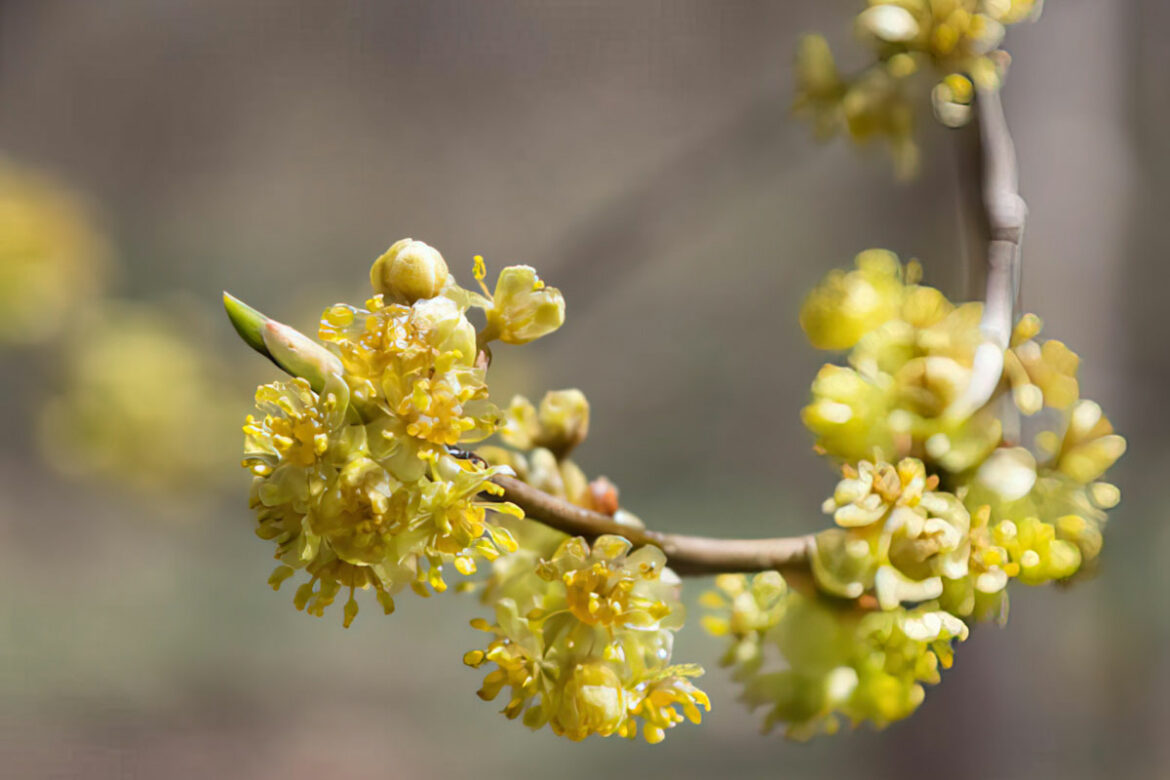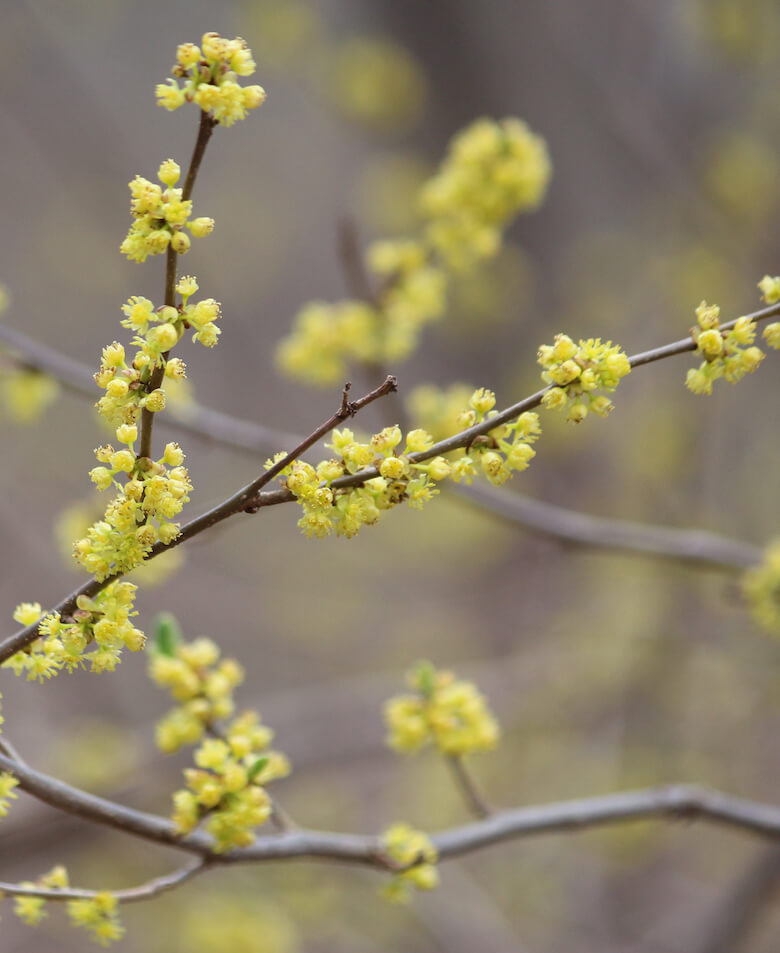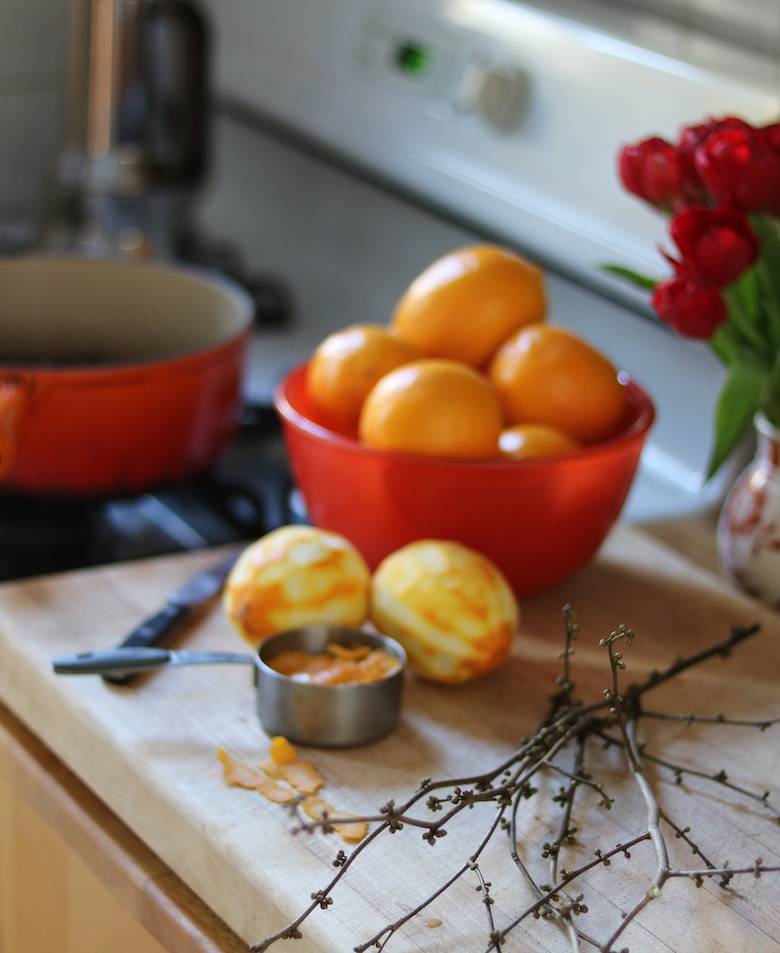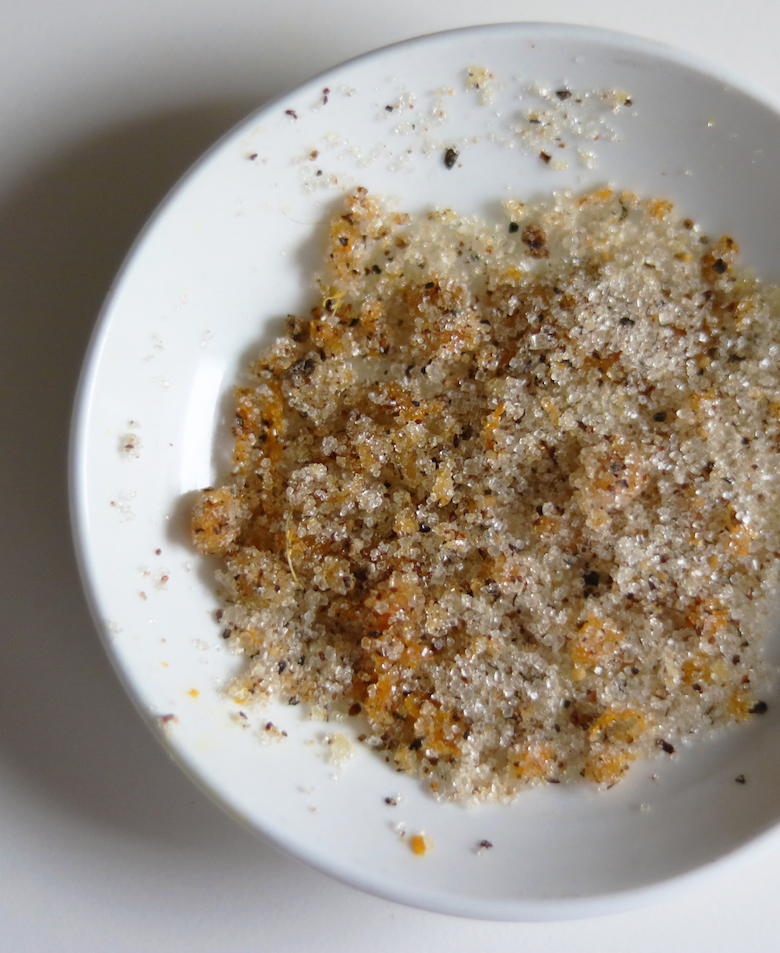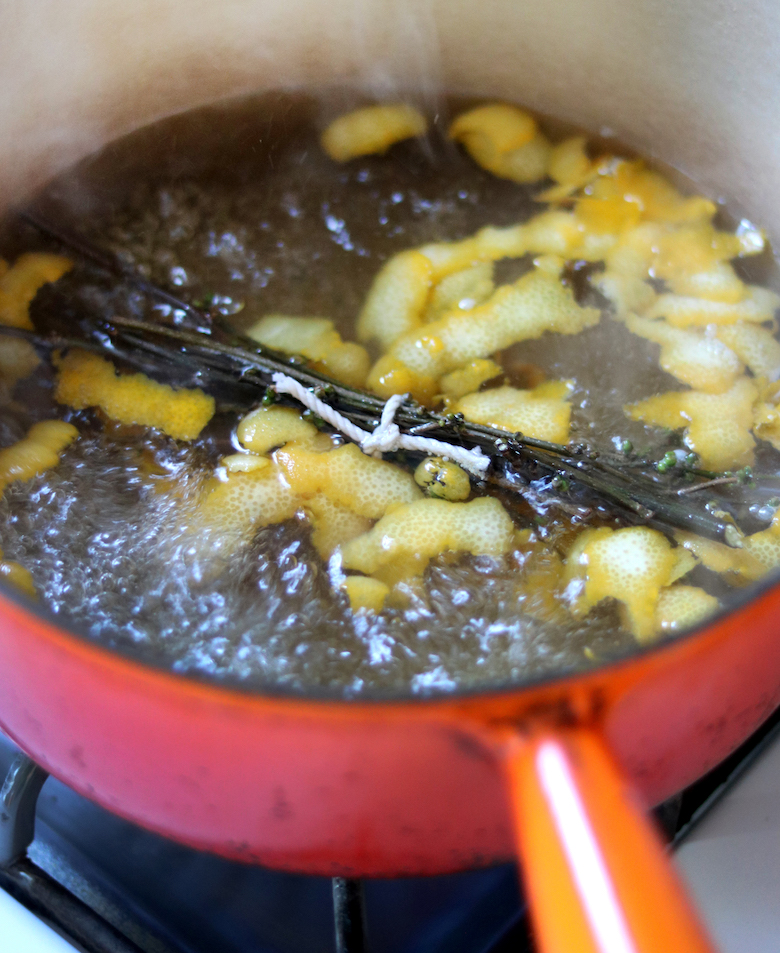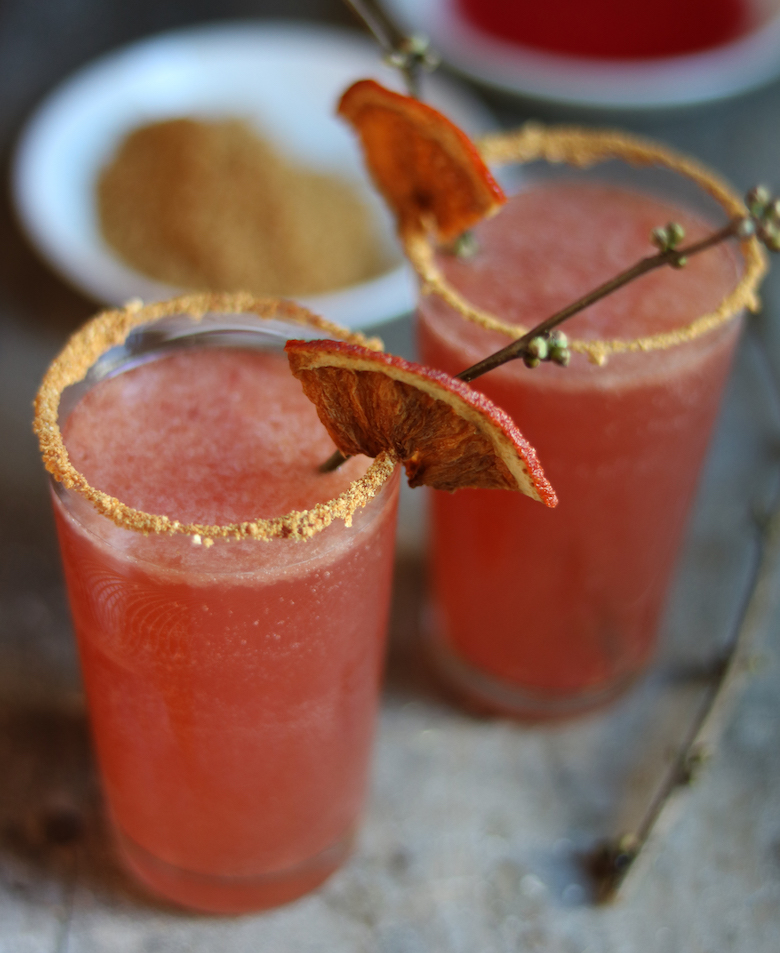Spicebush is distributed widely across the eastern United States, populating the understories of mixed deciduous woodlands and river bottoms. Its colloquial names spill its powerful secret; if you stop in the cold, bare-leafed woods and scratch its slender twigs, it releases a penetratingly complex scent: orange zest, cypress, juniper, fresh pine, pepper. Its twigs, buds, flowers, leaves, unripe and ripe fruit are all edible, and intensely aromatic. The most concentrated flavor is held in the red, late-summer-ripening fruit, which can be used fresh or dried. If it were better known, this would be the touchstone of a regional and indigenous North American culinary culture.
In the kitchen
In my own kitchen, spicebush is a staple ingredient throughout the year, where its generous flavor profile makes its application almost endless. In Forage, Harvest, Feast (Chelsea Green, Fall 2018), my wild foods cookbook, the spicebush chapter threatened to get out of hand. Despite exercising restraint, this seductive spice appears in over 50 of the book’s 400-plus recipes. Citrus may be the spirit fruit of spicebush. I reduce orange juice and its zest with dried spicebush, before bottling and chilling the concentrate for cold-weather cocktail shaking. Another extract I make with the fruit includes Meyer lemons, clementines, ginger, homegrown Thai limes and cardamom leaves. As mixers, both pair spectacularly well with bourbon, tequila reposado and dark rum. A gentler spring spicebush twig and lemon zest syrup complements gin, silver tequila and white rum.
The plant itself is a boon not only to mixologists and cooks but to birds and pollinators. Its manageable size and vast gustatory appeal makes it ideal for constrained urban kitchen gardens. Locally you will find it at The Gowanus Nursery in Brooklyn. For fruit production, you need male and female plants, but with scented twigs, flowers and leaves, even a lowly male will provide hours of culinary pleasure.
Exploring potential
In an exponential curve, a small but connected community of Northeastern foragers is also exploring the potential of this native American flavor. They share their discoveries on Instagram, where a spicebush love is spreading, fueled by hashtags and infectious curiosity. Scroll down to read more of their tips.
While these foragers (and I) use the plant widely in cooking, one of the most effective ways to experience its adaptable flavor is in drinks: Infusions, extractions, syrups, ferments and teas extract the essence of its character. I make the following effervescent ferment with winter and spring twigs and farmers market apples. It mixes beautifully with sparkling water, tequila, bourbon and gin and is also the first step in making your own wild vinegar.

Apple and spicebush bud fizz
Makes 4 cups
2 ounces spring spicebush twigs 1½ pounds apples, cut up, not cored or peeled 1 cup sugar 4 cups water
To make the ferment: Combine the ingredients in a clean glass jar. Close the jar and tilt back and forth until the sugar dissolves. Remove the lid. Tie cheesecloth over the jar’s mouth with string. Place on a counter and stir daily. It will start bubbling within about 24 to 48 hours. On day 7 or 8, when it is good and fizzy, strain the liquid. Strain it again through cheesecloth. Bottle, and keep in the fridge. (Left out in the warmth, a still-fermenting bottle can explode).
To make vinegar: Return the strained ferment to the jar, cover with cheesecloth, and wait, swirling daily until a vinegar mother forms (it may not). When it smells and tastes like vinegar it is vinegar (3 to 5 weeks, generally). Transfer to narrow-necked bottles and seal.
—
Additional spicebush ideas
Private chef Paloma Sendrey (@bestgirlfriday) grew up foraging in Mexico. Now, in the woods above the Hudson River, the Riverdale resident collects yellow spicebush leaves in the fall, keeping them in her pocket as she walks, describing their scent as “beyond divine.” In spring she crushes and scorches the twigs, macerates them in bourbon, and adds satsuma juice—a wild-inspired old fashioned.
Food stylist, photographer and cook Melina Hammer (@melinahammer) was introduced to spicebush in New York City parks by her friend, wild foods author Leda Meredith. She suggests using a spring-twig-infused syrup as a stand-in for Cointreau in a feral margarita. And in summer she makes a sun tea with foliage foraged from local and New Jersey woodlands.
Self-described budding forager Sana Ashraf (@maisonmelimelo) lives on Long Island but forages in upstate New York and describes spicebush as “the love child between cinnamon and grains of paradise.” From Pakistan, she likes strong flavor combinations and says she has not yet found one where spicebush does not work. In terms of drinks she awards the Oscar to spicebush-inflected eggnog: “It is LOVELY…” she writes in an email.
Writer and New Jersey forager Mallory O’Donnell (@mallorylodonnell) lives in semi-rural Hunterdon County, where the local woods “are abundant with spicebush.” Mallory recommends gathering branches and fruit from healthy populations of trees near paths that would otherwise be pruned for trail maintenance. In winter they make a spicebush twig tea that is deployed in kombucha and in a shrub with spicebush flower vinegar.
Further north, Connecticut subsistence forager Carrie (@littlelichen)—who prefers not to use her last name—first met spicebush on her family’s farm, as a child. “It was true love from there on out,” she says. Almost every morning she grinds one or two dried ripe spicebush fruits into her family’s coffee before it goes into the French press. One of her favorite tea and broth bases is a blend of dried matsutake mushrooms with dried spicebush, sassafras leaves and sweet birch twigs. “The spicy cinnamon note of the matsutake and the allspice character of the spicebush are perfect together,” she says. This story was originally published in March 2018.


